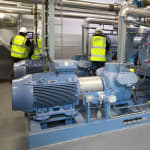
There are obvious reasons for installing heat pump solutions in the industry. Some do it to reduce operating costs and thereby increase their competitiveness, others choose to do it as part of their long term sustainability targets in line with the company image and finally there are industries which have to change their heating solution away from burning fossil fuels in order to meet regulatory requirement for reducing the environmental impact we all have on our planet. It can be just one, but mainly all of the benefits above that is the reason why heat pump solutions are installed. Whatever the reason is: energy-efficient heat pumps from GEA are rapidly becoming the technology of choice on the road to a carbon-neutral future. The high efficiency and low maintenance of GEA heat pumps give a short payback and continues to benefit the customer throughout the long lifecycle (min 20 years) of the installation. By replacing burning fossil fuels: CO2 emissions which are harmful to global climate and NOx emissions which are harmful to the local environment are avoided.
In addition, environmentally friendly natural refrigerants such as ammonia are used. The food industry in particular recognises the considerable financial and ecological advantages of using heat pumps in production processes. Most food processing is a combination of heat treatment and subsequent cold storage for long shelf life. This combination of heating and cooling maximizes the benefit of heat pump installations. GEA heat pump technology offers energy saving advantages regardless of the industry and the extent of its use. Besides applications in the processing industry, heat pumps are also often used in environmentally friendly district heating schemes, where they are being used not only to provide the base heat load, but also as adjustable heat source, their quick reaction time is a good match with large district heating networks. In these schemes they also play an important part of protecting the electrical grid as part of smart energy systems, where loads can be adjusted online according to request from the electrical supplier.
Combining climate protection with cost reduction
According to the International Energy Agency (IEA), heat accounts for more than half of the world's final energy consumption, with most of this being generated from fossil fuels. In industry and commerce, the demand for hot water and process heat is very specific. It can often be met with heat pumps. Their efficiency and short payback period make them an environmentally friendly and economically attractive alternative to conventional heating systems. A heat pump converts heat from the environment - water or process waste heat - from a low temperature level to a higher one.
The type of application is decisive when planning and selecting a heat pump system: The variety of industrial heat pumps makes them interesting for numerous applications where both heating and cooling is required. The smaller the temperature lift is for the heat pump the less electrical power is required. For heat pump installation it is important to find the highest temperature heat source and optimize the heating system for supplying the lowest practical hot water temperature. If the demand for heating and cooling changes seasonally, typically in office buildings or greenhouses, a GEA heat pump can heat in winter and cool in summer. In the seasons where both heating and cooling is required, the efficiency can be more than ten times higher than a conventional installation with boiler for heating and air conditioning for cooling.
GEA experience with cooling systems as a decisive advantage
GEA's technicians are experts in both cooling systems and heat pumps. With more than 100 years of manufacturing ammonia refrigeration and more than 10 years knowledge from high temperature heat pumps installations the reasons are obvious. Heat pumps and refrigeration systems use the same physical principle - and they all consist of the same main components, such as compressors and heat exchangers. The principle of the heat pump is also used for cooling (as with the refrigerator), while the term "heat pump" is only used for the heating unit. In the cooling process, the useful energy is the heat absorbed from the process/cold store to be cooled, which together with the drive energy is dissipated to the environment as waste heat.
When a heat pump is combined with a cooling unit, both cooling and heating are possible, so that the one-time use becomes a continuous cycle, which reduces energy costs by 30 percent or more. This is a significant saving when you consider that in the food, dairy and beverage industry up to 60 percent of energy consumption can be used for heating and cooling.


